Essential Guide to Choosing Industrial Chairs for Your Workstation
From ESD cleanrooms to offices - key features and tips on what to look for in industrial seating

Industrial Seating: Enhancing Productivity and Safety with the Right Chair
Whether it’s a corporate office, a high-tech laboratory, or an industrial production floor, selecting the right seating is crucial. The ideal chair should enhance well-being and efficiency while adhering to stringent safety and ergonomic standards.
Features of Quality Industrial Seating
The right seating should withstand daily use while ensuring comfort for its users. When selecting the right chair for your workstation, it is important to consider these factors:
- Functionality and comfort (chair ergonomics)
What kind of work is the user doing? Will the user be seated for prolonged periods, or requiring frequent upper-body mobility? - Work environment
Specific safety and business requirements may be required, especially in high-tech sectors such as advanced manufacturing, precision engineering, semiconductor manufacturing, biopharmaceuticals, and the like. - Maintenance and upkeep
How will you be maintaining the chair? Will the chair be exposed to grease or chemical substances?
Chair Ergonomics
Ergonomics – when comfort meets functionality – is crucial in any chair. A good chair provides necessary support to its user’s back, legs, buttocks, and arms. It maintains natural curvature while reducing exposure to awkward postures, contact stress, and forceful exertions.
Features such as adjustability, seat pan contour, seat height, backrest design, foot rest and armrest should be considered – right down to the chair base and wheels! These features can be customised to fit various body types and work scenarios.
In general, increased adjustability ensures a better fit for the user, and provides adequate support in a variety of sitting postures. This is particularly important if the chair has multiple users.
Seat Contour
For maximum comfort, the seat should be adequately padded and contoured. A “waterfall” seat features a slightly curved front edge design that provides support for the user’s thighs. Over prolonged seating, this helps minimise pressure on the legs, while encouraging blood flow and supporting comfortable seated postures.
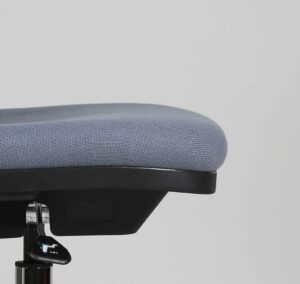
The slightly curved “waterfall” seat on Megatek’s seat pan minimises pressure on thighs and legs, and offers better support to the seated user.
Seat Pan and Depth Adjustability
The seat pan width should be appropriately sized to accommodate a majority of hip sizes. An inappropriately-sized seat pan will cause excess pressure on the buttocks or the knees, minimise back support, and restrict blood flow, causing discomfort and pain. Adjustable seat depth is also essential, especially in chairs shared by multiple users, to accommodate different body sizes and prevent strain.
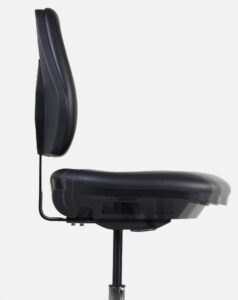
Megatek’s 9S Series Cleanroom ESD Chair features an adjustable seat depth of 50mm backward and forward. An ergonomic chair feature that accommodates different users and postures.
Seat Height
Seat height should be adjusted such that the user’s feet is able to rest flat on the floor, while keeping their knees at an angle of 90° to promote good blood circulation.
Using a chair that is too high or low will lead to awkward postures, fatigue, restricted circulation, swelling, numbness, and pain over prolonged periods.
Backrest
A good backrest supports the natural S-shaped curvature of the spine. This is also known as lumbar support. Good lumbar support reduces the risk of back discomfort and fatigue.
As recommended by ergonomic guidelines, a backrest should be adjustable in height and angle (tilt) to ensure it fits snugly into the small of the user’s back. The ability to recline is also crucial, as it allows for dynamic sitting that promotes better posture and comfort.
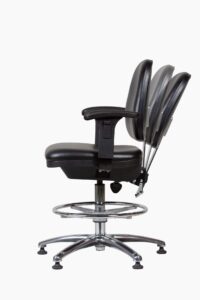
Megatek’s 7P Industrial Cleanroom ESD Chair features an adjustable backrest of up to 15°. The backrest allows different users to adjust the seat for their comfort and dynamic sitting postures. An optional armrest and footring can enhance the versatility of an industrial chair.
Chair Castor Wheels
Load-dependent castor wheels are an excellent choice for industrial seating, providing additional safety, especially in high-traffic areas, or workstations where users are expected to sit and stand frequently. These chair castor wheels can be activated or deactivated upon load (a user’s weight).
Self-braking chair castors will only allow a chair to be moved around freely when a user is seated on it. When there is no one seated, the castor wheel brakes are applied.
Brake-loaded chair castors allow a chair to be moved around freely when no one is sitting on it. A user’s weight will activate the castor wheel’s brakes, keeping the chair stationary when someone is seated on it.
Add-on Components: Armrests, foot rests
Height-adjustable armrests and foot rests can be added on to further enhance the versatility and range of your chairs and stools. These accessories make the chair or stool even more adaptable to various tasks, work environments, and users.
Foot rests, or footrings provide additional support for users who may not reach the floor comfortably, even with adjustable seat heights.
Height-adjustable armrests allow for better shoulder and arm positioning, which is crucial for tasks involving the use of tools or computers.
Safety and Compliance
In controlled environments like cleanrooms and static-sensitive environments, seating must meet specific technical standards. This ensures the safety of the user and the components he or she is working with.
High-sensitivity environments
For seating used in Class 10, 100, and 1000 (ISO 4, 5, 6) Cleanrooms, or when working in static-sensitive environments, ESD-safe equipment is crucial for the safety of the user and in preventing static damage. This applies to every component in the environment, including seating. The construction and materials used for cleanroom ESD chairs and stools need to be ESD-safe.
Common standards to look out for include ISO 14644-1 and ANSI/ESD STM12.1 ESD test standards.
General safety standards
In more generalised and versatile environments such as corporate offices, seating should also comply with the Occupational Safety and Health Act (OSHA) and the Business and Institutional Furniture Manufacturer’s Association (BIFMA) standards (ANSI/BIFMA X5.1-2002).
These standards provide guidelines on ergonomic practices and safety.
Materials and Construction
The surrounding environment of the chairs would impact the make and build of your industrial seating.
For harsh environments like production floors and laboratories, choose materials that can withstand frequent wipedowns, exposure to chemicals, and exposure to sharp tools. Materials like tough industrial vinyl should be used.
Meanwhile, for static-sensitive environments such as in electronics or high-tech manufacturing, chairs and stools should be constructed with electrostatic discharge (ESD) safe materials. These are commonly known as ‘ESD chairs’ and are designed with conductive components to mitigate risks in static-sensitive environments.
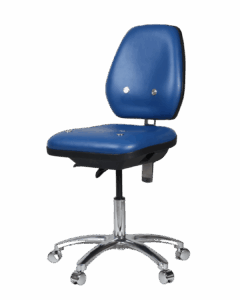
Megatek’s 9G Conductive Industrial Chair comes with proprietary G-STUDS embedded in its seat pan and backrest, providing additional grounding points and enhancing safety during use.
For cleanroom applications, look out for ISO-classified chairs with smooth, non-shedding materials suitable for your cleanroom standards. Common certifications to look out for include ISO 14644-1 and ANSI/ESD STM12.1.
In less specialised areas like corporate offices, chairs should still offer ergonomic benefits and durability for various industrial tasks. Look out for quality materials like reinforced aluminium or stainless steel that promise durability and resilience.
For high-traffic areas, opt for sturdy, five-pronged chair bases for greater stability. A polished trumpet base is a great choice, without potential trip hazards.
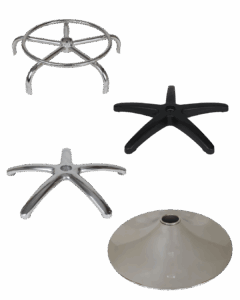
For ultimate support, stability, and safety, five-pronged chair bases are recommended. Choose from a selection of chair bases that can suit various environmental requirements.
In high-humidity environments like Singapore, traditional seating with plywood construction may promote bacterial growth over time and introduce mold.
Checklist: Questions to Ask Your Industrial Seating Specialist
Before finalising your choice of industrial seating, it’s crucial to discuss your specific needs with a seating specialist. Here are some questions you should consider asking:
- Can the seating be customised to meet the unique ergonomic needs of my users?
- What certifications do these chairs and stools have for compliance with industry-specific safety and environment standards?
- How do the adjustment features work? How can I use them to accommodate different users and work tasks?
- What kind of technical service support do you offer? Are the parts readily available?
- What kind of warranty is offered with these chairs?
After all that is said, the ideal workstation chair should complement your workflow and operations.
This guide is designed to assist you in making an informed decision for your industrial seating needs, promoting a safer and more productive environment.
For more information or to discuss your specific requirements, do not hesitate to contact us.


